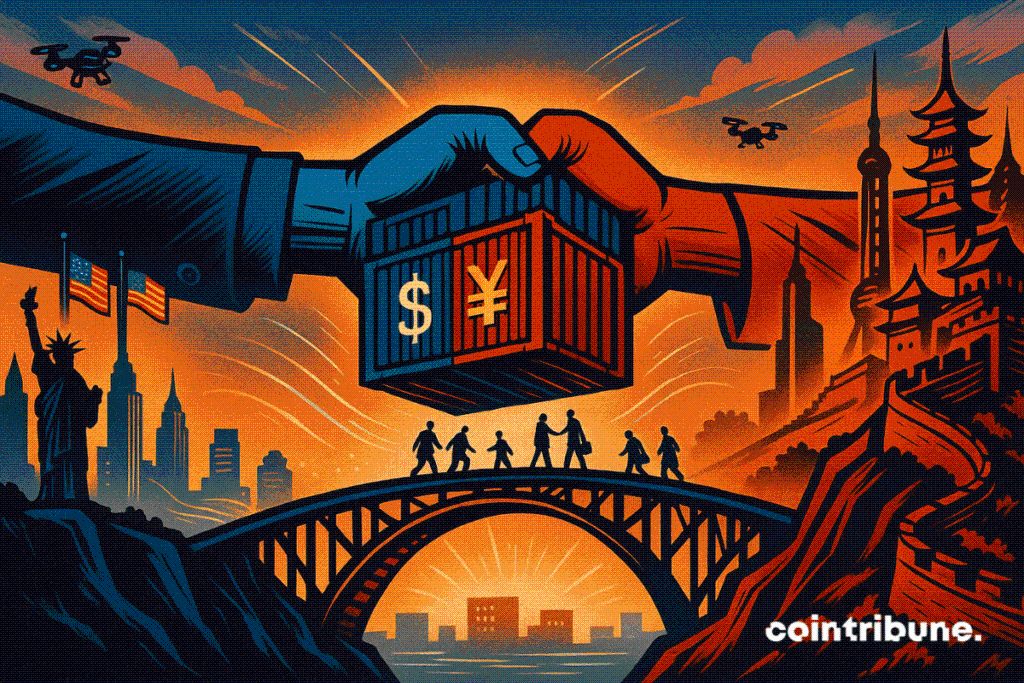. @SecScottBessent on China: "President Trump gave me a great deal of negotiating leverage with the threat of 100% tariffs on November 1st — and I believe we've reached a very substantial framework that will avoid that and allow us to discuss many other things with the Chinese." pic.twitter.com/mUz1k9kZpu
— Rapid Response 47 (@RapidResponse47) October 26, 2025
Strategic Trade De-escalation Underway Between US And China
By: Cointribune
Summarize this article with:
ChatGPT Perplexity Grok
A strategic turn is emerging between Washington and Beijing. On the eve of a summit between Donald Trump and Xi Jinping, the two powers announce a preliminary agreement to defuse a trade war with global repercussions. This unexpected but calculated signal of détente resonates even in financial markets and the crypto ecosystem, historically reactive to geopolitical tensions. In a context where tariffs and technological restrictions fueled uncertainty, this opening rekindles hope for a sustainable normalization of Sino-American trade.

In brief
- A preliminary trade agreement between the United States and China has been announced, ahead of a strategic meeting between Donald Trump and Xi Jinping.
- Negotiations were facilitated on the sidelines of the ASEAN summit, amid tensions over rare earth elements and tariffs.
- Washington and Beijing are discussing a gradual de-escalation, with the potential removal of U.S. tariffs and a temporary freeze on Chinese restrictions.
- Treasury Secretary Scott Bessent described it as a “very substantial framework” and stated that tariff threats had strengthened the American position.
Towards a Strategic Trade De-escalation Between Washington and Beijing
A few days before a key bilateral meeting between Donald Trump and Xi Jinping , the United States and China announced that they have reached a preliminary trade agreement framework, during discussions held on the sidelines of the ASEAN summit in Kuala Lumpur.
This initiative aims to stop a spiral of tensions that confronted the two largest economic powers worldwide on several fronts. “The United States and China want to reach an agreement”, stated Donald Trump, expressing his willingness to host Xi in Washington or at Mar-a-Lago, his Florida residence. Although Chinese authorities have not yet publicly detailed the contents of this framework, the tone adopted by both parties shows a significant diplomatic shift between Washington and Beijing.
This willingness to ease tensions occurs in a context still marked by strong strains. Indeed, Beijing has decided to further restrict rare earth exports, which are essential to US technological and defense industries. In retaliation, Trump had threatened to impose additional 100% tariffs on Chinese imports starting November 1st.
The contours of the agreement mentioned include :
- The gradual removal of new US tariffs, if the terms of the agreement are validated ;
- A one-year suspension of Chinese restrictions on rare earths as a goodwill gesture ;
- The confirmation of an official meeting between Trump and Xi in South Korea to finalize the agreement, on the sidelines of the APEC summit.
Washington authorities see in this framework a serious basis to break the deadlock. However, at this stage, no official document has yet been signed, and some uncertainty remains about the concrete implementation of the measures discussed.
Scott Bessent Sets the Tone, Cryptos React
It is Scott Bessent, US Treasury Secretary, who provided the most precise comments on the progress of the negotiations. He states : “I believe we have reached a very substantial framework that will avoid the imposition of 100 % tariffs and allow us to discuss many other issues with China”.
He adds that the tariff threat brandished by Trump gave him considerable negotiating leverage. The stake here is not only commercial. It is the first time in months that a senior US official speaks of a genuine de-escalation framework, strengthening the credibility of a lasting deal. The announcement came shortly before confirming a bilateral meeting at the APEC summit, planned for October 31, between Trump and Xi.
These signals immediately triggered a measured but clear reaction from the crypto market. Bitcoin gained 1.8 %, Ether 3.6 % and Solana 3.7 % in the hours following Bessent’s statement.
The sensitivity of cryptos to geopolitical tensions has once again been confirmed. For example, Trump’s announcement of 100 % tariffs on October 11 caused a sharp drop on some altcoins, up to -99 % on some mid-sized market caps.
Conversely, the prospect of a stabilizing agreement and accommodative monetary policy in the United States, with the Fed expected to cut rates, fuels bullish expectations. “Asset prices will get crazy this week if the deal is signed”, tweeted Anthony Pompliano, co-founder of Morgan Creek Digital.
However, this renewal of optimism should not overshadow persistent uncertainties. The framework mentioned has not yet been formalized by the two parties in the form of a binding agreement. China, cautious, remains silent on the concessions it might be willing to make, notably in the technology sector and intellectual property rights. If the momentum is real, its consolidation will depend on the Trump–Xi meeting and the ability of the two heads of state to overcome political posturing. For the crypto market often affected by trade tensions , the stake is major: a de-escalation could pave the way for a return of overall confidence, hence capital flows, while a negotiation failure would reignite uncertainty.
Disclaimer: The content of this article solely reflects the author's opinion and does not represent the platform in any capacity. This article is not intended to serve as a reference for making investment decisions.
Lock now!
You may also like
Crypto prices
MoreBecome a trader now?A welcome pack worth 6200 USDT for new users!
Sign up now